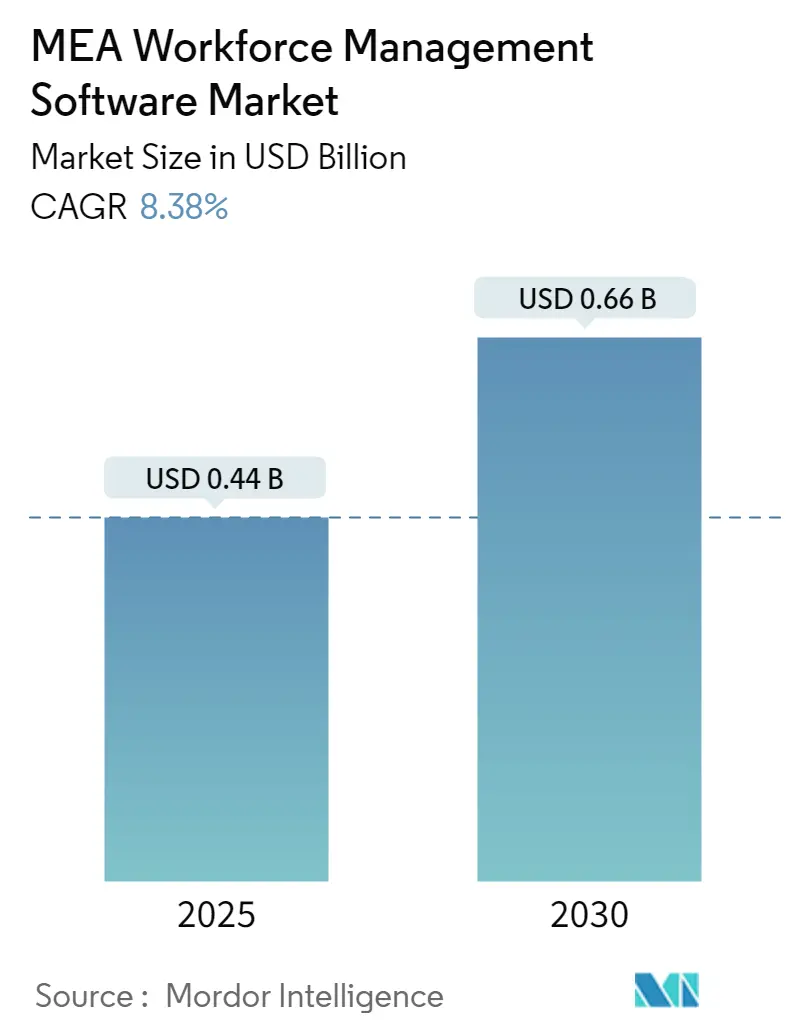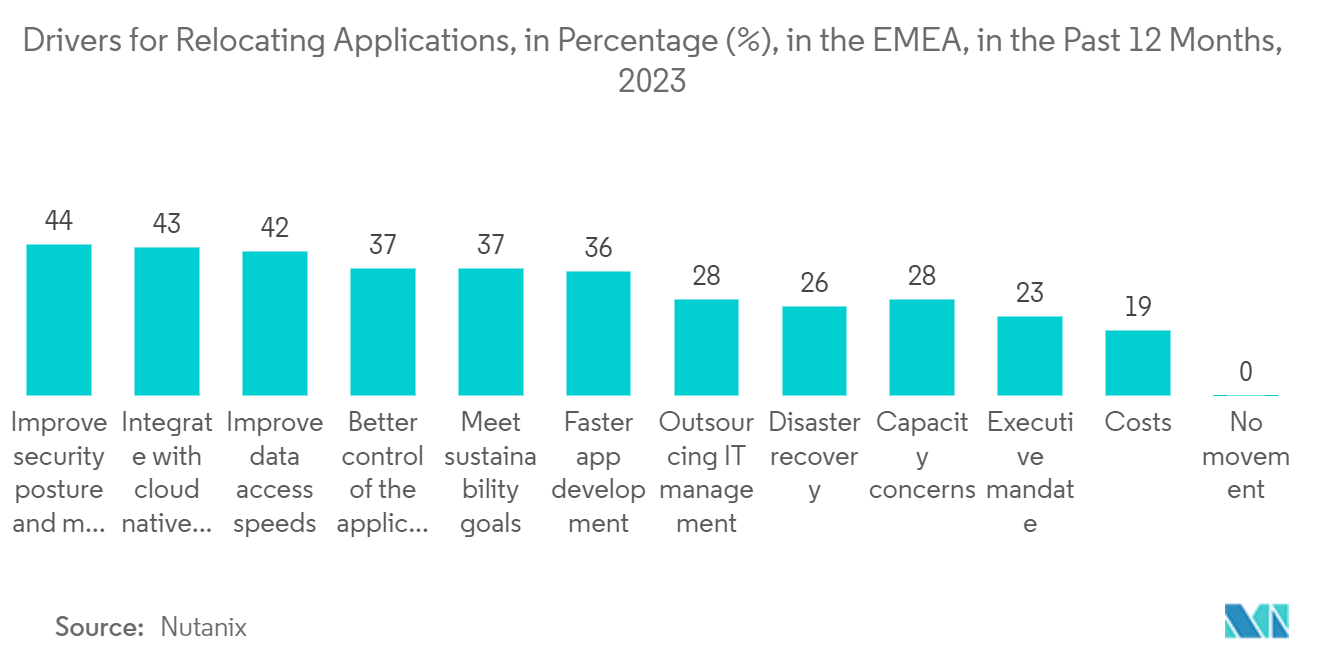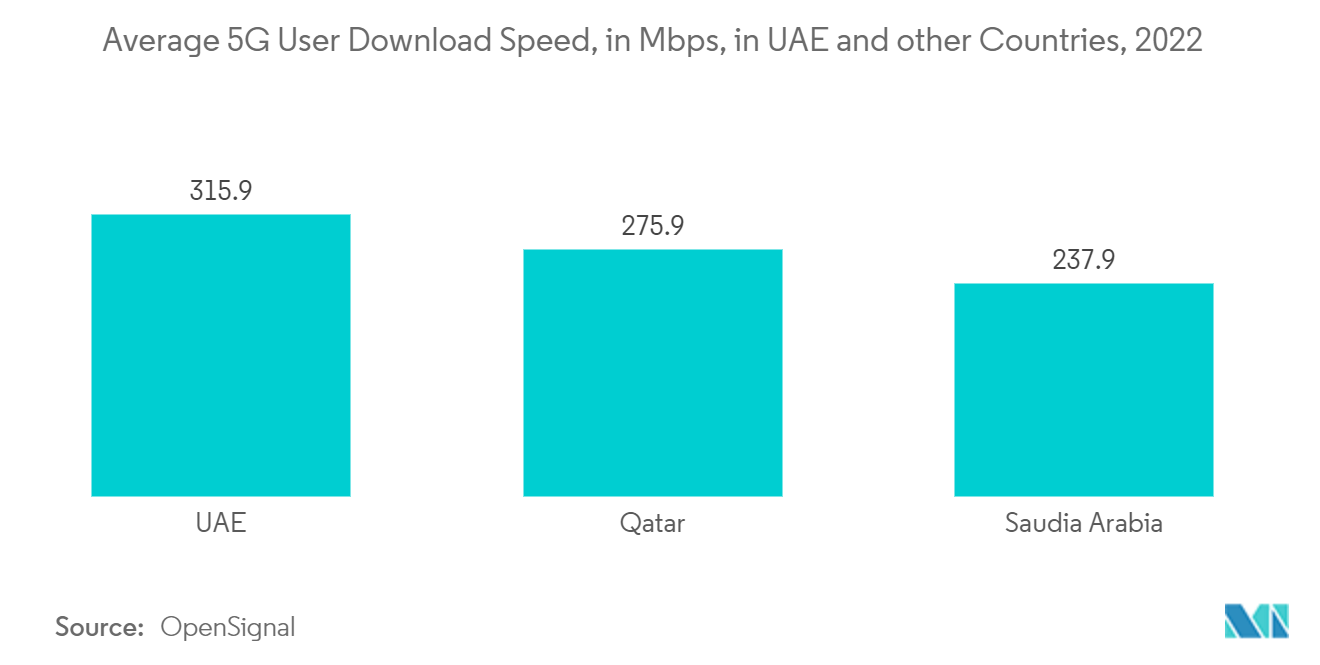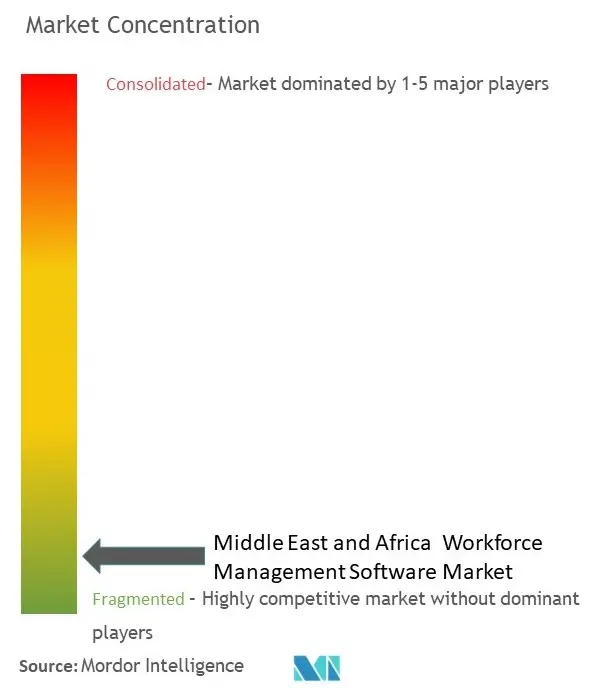
| Study Period | 2019 - 2030 |
| Base Year For Estimation | 2024 |
| Forecast Data Period | 2025 - 2030 |
| Market Size (2025) | USD 0.44 Billion |
| Market Size (2030) | USD 0.66 Billion |
| CAGR (2025 - 2030) | 8.38 % |
| Market Concentration | Low |
Major Players
*Disclaimer: Major Players sorted in no particular order |
MEA Workforce Management Software Market Analysis
The MEA Workforce Management Software Market size is estimated at USD 0.44 billion in 2025, and is expected to reach USD 0.66 billion by 2030, at a CAGR of 8.38% during the forecast period (2025-2030).
- The increasing usage of advanced technology, such as artificial intelligence, drives the workforce management market. The growing need of small and medium-sized organizations for the Internet of Things and the ever-increasing popularity of remote workforce solutions will intensify the demand for workforce management. Smartphone penetration is increasing, and businesses focus more on human resource analytics, leading to more profitable growth prospects in the workforce management industry.
- Companies can utilize AI in workforce management to assess their existing employees' talent inventory and leverage historical skill data to match individuals with appropriate open positions advertised by managers while considering skills adjacency, prior experiences, and intended career paths. Workers receive better visibility into a diverse pool of projects and experiences available within their business that would otherwise be inaccessible due to the value-add of personalized recommendations that serve up appropriate opportunities. For example, Saudi Arabia will invest USD 20 billion in Artificial Intelligence by 2030. This may create an opportunity for the market players to incorporate AI in workforce management solutions.
- The increasing adoption of IoT and cloud-based solutions is reshaping the workforce management software market by enhancing data-driven decision-making, enabling remote workforce management, and providing scalability and cost-effectiveness for businesses. The workforce management software market will experience further growth and innovation as these technologies evolve and are expected to experience further growth and innovation.
- The growing adoption of analytical solutions and workforce management software by SMEs in the MEA region is driving market growth. As more businesses recognize the advantages of these technologies, the demand for workforce management software is expected to continue to rise in the coming years.
- The MEA workforce management software market may face several implementation and integration concerns hindering the market. Data security and privacy are critical concerns for organizations in the MEA region; businesses may hesitate to move their employee and operational data to cloud-based workforce management solutions due to data breaches and regulatory compliance concerns.
- Over the last decade, remote employment has become increasingly popular. Nevertheless, COVID-19 significantly accelerated this trend in a short time, compelling businesses of all sizes to rapidly adopt the self-isolation measures that governments in the region were advising. Because it can assist in effectively handling the remote workforce and the pandemic's requirement for more people to work remotely, remote workforce management software has emerged as a crucial tool for businesses.
- According to the IMF, the UAE economy recovered swiftly from the effects of COVID-19, with strong near-term economic growth supported by a pickup in domestic activity and high surpluses in the fiscal and external balances. According to the most recent IMF estimate, the UAE GDP growth is predicted to increase to above 6% in the current year from 3.8% last year. Fiscal surpluses have grown despite rising oil costs and a gradual reduction in fiscal support for households and businesses due to the COVID crisis.
MEA Workforce Management Software Market Trends
Workforce Scheduling and Workforce Analytics Type is Expected to Hold Significant Market Share
- Workforce analytics is gathering workforce-related data from internal and external sources, analyzing it, and transforming it into actionable information. By collecting employee data, workforce analytics enables users to make better strategic business decisions about personnel, provide ROI evidence for workforce-related choices, and improve overall business outcomes.
- Workforce analytics look at the work itself rather than just the people. It tracks and analyzes employees' work productivity to improve workflow and enable HR leaders to make data-driven decisions that enhance employee success and experience.
- The advantages of workforce analytics for organizations revolve around tracking employee performance to establish a baseline for meeting objectives and driving efficiency. The most significant benefits of collecting and analyzing workforce analytics include workplace analytics, which helps identify the demand for new functions and positions early on, resulting in better hiring criteria. It also aids in identifying qualified candidates more quickly and providing more value during the hiring and onboarding process. Workforce analytics helps to break down data silos and centralize all the workforce data in one place. This allows for increased visibility, self-service, a more comprehensive data set, and improved communication among decision-makers.
- Moreover, using workforce analytics can aid in developing a culture of trust and transparency in which individual employee contributions are recognized and rewarded. Workforce analytics leave a data trail for employees to see who is being recognized and why. It enhances monitoring. Workforce analytics enables business leaders to track progress against set benchmarks by monitoring the inputs and outputs of their pre-post-employee hiring processes.
- Workforce scheduling solutions have evolved to the point where they are automating multiple operational issues that managers previously faced when optimizing workforce management. Currently, AI-powered solutions are available to handle larger workloads, predict needs with changing seasons, and optimally create schedules for shift workers. Furthermore, these solutions allow employees to take control of their programs and switch shifts with other employees directly if necessary.
- Workforce scheduling and workforce analytics are fundamental considerations when relocating applications in the workforce management software market. They play an integral role in ensuring the software's security, compliance, and performance in a new environment. According to Nutanix software company, in 2023, in the Middle East and Africa (EMEA), improving security posture and meeting regulatory requirements is the top driver for relocation applications, with about 44 %of the respondents reporting the same. This is followed by integrating cloud-native solutions with a 43 % share.

United Arab Emirates is Expected to Hold Significant Market Share
- Companies all over the United Arab Emirates region are setting ambitious transformation roadmaps into practice to guarantee their relevance in the digital world. Third platform usage is spreading throughout the region, and embracing technologies like cloud, mobility, and social is becoming more common.
- Additionally, the area is witnessing an increase in the number of local players in the IT industries who are creating solutions to meet the rising local demand. For instance, in January 2023, To equip organizations in the Middle East and North Africa (Mena) with the necessary tools to thrive in the rapidly changing workplace, Darwinbox, the fastest-growing unicorn in the HR tech space, announced a partnership with Microsoft. Deep integrations between Darwinbox and the Microsoft product ecosystem will be a part of the cooperation, as will joint innovation of solutions to improve the employee experience. To advance its goal of enabling organizations to integrate their complete employee lifecycle, Microsoft has also made an equity investment in Darwinbox in addition to the co-innovation roadmap.
- In December 2022, the Emirates Integrated Telecommunications Company (EITC) subsidiary du announced a collaboration with Nokia to improve employee skill sets and quicken initiatives to promote talent development in the UAE. As part of the agreement, Nokia will implement programs to train and grow its employees' technological proficiency and knowledge transfer.
- In January 2023, To increase its capabilities as a top supplier of turnkey security, facility management, and human resources outsourcing solutions in the UAE, ReplWorld Security, a DP World company, entered into a strategic alliance with Transworld Group. The businesses will work together to find ways to hire people abroad by finding, developing, and training skilled workers in the Indian subcontinent.
- The United Arab Emirates economy is expanding, as are the region's sectors, labor force, and several businesses. The cities in this area have recognized their potential, and with the money generated from selling these natural resources, living standards are rising, and regional stability is returning.
- In this area, skilled labor is crucial for managing the nation's resources. Also, by using workforce management software, cities in the area can boost production and revenue from their respective industries. One of the biggest trends in the region has been the Industrial Revolution 4.0, and the digital transformation is anticipated to increase considerably over the forecast period along with the quickly expanding 5G infrastructure. According to OpenSignal, UAE had the fastest average 5G download speed in 2022 at 315.90 Mbps. Qatar and Saudia Arabia rounded out the next at 275.90 Mbps and 237.90 Mbps, respectively.

MEA Workforce Management Software Industry Overview
The Middle East and African Workforce Management Software Market is highly fragmented, with major players like Active Operations, Management International LLP, NICE Systems Ltd, Oracle Corporation, Infor Group, and Kronos Incorporated ( UKG Inc.). Players in the market are adopting strategies such as partnerships and acquisitions to enhance their product offerings and gain sustainable competitive advantage.
In February 2023, Workforce Africa, the HR solutions provider, announced its further expansion in Lesotho and Gabon. The company provides HR services like compliant payroll management, recruitment, assessment, HR support, employee benefits, independent contractor management, background verification, and more to global businesses. The expansion plans will pave the way for international businesses investing across the African continent.
In October 2022, DU Telecom signed a contract with Oracle Cloud Human Capital Management (HCM) to manage its HR processes across the UAE, including recruitment, compensation, and performance management. Due to this adaption, DU Telco will standardize HR procedures on a shared data platform, improving the organization's team management and HR services.
MEA Workforce Management Software Market Leaders
-
Active Operations Management International LLP
-
NICE Systems Ltd
-
Oracle Corporation
-
Infor Group
-
Kronos Incorporated (UKG Inc.)
- *Disclaimer: Major Players sorted in no particular order

MEA Workforce Management Software Market News
- January 2023: BrightPlan, a United States-based company, launched a new workforce financial wellness gauge, providing data-driven insights for organizations to uncover key workforce strengths and gaps in the Middle East and Africa region. BrightPlan's Total Financial Wellness solution, powered by patented AI technology, transforms raw data into valuable insights and advice for employers and employees.
- October 2022: Darwinbox (provider of cloud-based Human Resources Management Software) expanded its business reach in the Middle Eastern region by opening a new office at Dubai International Financial Centre (DIFC). This will advance its business connection with enterprises, investors, and partners.
MEA Workforce Management Software Industry Segmentation
Workforce management software enables organizations to centralize resource usage data and better plan future utilization. It allows companies to create custom workflows to be more efficient in their decision-making processes and protect data integrity. To manage several aspects of the workforce for better productivity, the market software solutions include workforce forecast and scheduling, time and attendance management, task management, HR management, and other solutions, including workforce analytics.
The Middle East and African Workforce Management Software Market is segmented by type the market is segment into workforce scheduling and workforce analytics, time and attendance management, performance and goal management, and absence and leave management, by deployment mode the market is segment into on-premise, cloud, by end-user vertical the market is segment into BFSI, consumer goods and retail, automotive, energy and utilities, healthcare, and manufacturing, by country the market is segment into United Arab Emirates, Saudi Arabia, South Africa, rest of Middle East and Africa. The market sizes and forecasts are provided in terms of value (USD) for all the above segments.
| By Type | Workforce Scheduling and Workforce Analytics |
| Time and Attendance Management | |
| Performance and Goal Management | |
| Absence and Leave Management | |
| Other Softwares (Fatigue Management, Task Management, etc.) | |
| By Deployment Mode | On-premise |
| Cloud | |
| By End-user Vertical | BFSI |
| Consumer Goods and Retail | |
| Automotive | |
| Energy and Utilities | |
| Healthcare | |
| Manufacturing | |
| Other End-user Verticals | |
| By Country | United Arab Emirates |
| Saudi Arabia | |
| South Africa | |
| Rest of Middle East & Africa |
MEA Workforce Management Software Market Research FAQs
How big is the MEA Workforce Management Software Market?
The MEA Workforce Management Software Market size is expected to reach USD 0.44 billion in 2025 and grow at a CAGR of 8.38% to reach USD 0.66 billion by 2030.
What is the current MEA Workforce Management Software Market size?
In 2025, the MEA Workforce Management Software Market size is expected to reach USD 0.44 billion.
Who are the key players in MEA Workforce Management Software Market?
Active Operations Management International LLP, NICE Systems Ltd, Oracle Corporation, Infor Group and Kronos Incorporated (UKG Inc.) are the major companies operating in the MEA Workforce Management Software Market.
What years does this MEA Workforce Management Software Market cover, and what was the market size in 2024?
In 2024, the MEA Workforce Management Software Market size was estimated at USD 0.40 billion. The report covers the MEA Workforce Management Software Market historical market size for years: 2019, 2020, 2021, 2022, 2023 and 2024. The report also forecasts the MEA Workforce Management Software Market size for years: 2025, 2026, 2027, 2028, 2029 and 2030.
Our Best Selling Reports
Middle-East and Africa Workforce Management Software Industry Report
Statistics for the 2025 MEA Workforce Management Software market share, size and revenue growth rate, created by Mordor Intelligence™ Industry Reports. MEA Workforce Management Software analysis includes a market forecast outlook for 2025 to 2030 and historical overview. Get a sample of this industry analysis as a free report PDF download.




